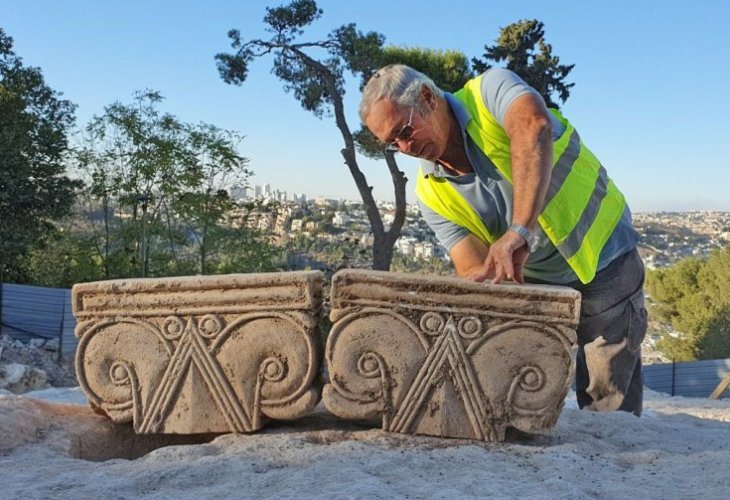(Video and editing: Yaniv Berman, Israel Antiquities Authority)<\/strong><\/p>A rare collection of dozens of intricately decorated stone architectural pieces, part of a magnificent structure dating back to the First Temple period, has been discovered during excavations by the Israel Antiquities Authority. This dig is preparing the site for a new visitor center along the Armon HaNatziv promenade in Jerusalem, funded by the Ministry of Tourism, Jerusalem Municipality, and the Elad Foundation.<\/p>
The findings were revealed today (Thursday) to the public at an event in the City of David within the Jerusalem Walls National Park, attended by Minister of Culture and Sports, Chili Tropper; Dr. Yuval Baruch, Jerusalem District Archaeologist at the Israel Antiquities Authority; and David Be'eri, director of the Elad Foundation.<\/p>
![The stone capitals from the royal estate (Photo: Shai Halevi, Israel Antiquities Authority)]() The stone capitals from the royal estate (Photo: Shai Halevi, Israel Antiquities Authority)
The stone capitals from the royal estate (Photo: Shai Halevi, Israel Antiquities Authority)The discovered stone items are made from soft limestone, expertly carved, including variously sized capitals in a style known in research as "proto-Ionic," typical of royal construction from the First Temple era and iconic of that period. This artistic design, representing the Kingdoms of Judah and Israel, is so significant that the Bank of Israel featured it on the five-shekel coin.<\/p>
The unearthed collection includes, among other things, three complete medium-sized stone capitals and fragments of elaborate windows with balustrades. These constructions incorporated styled columns topped with a series of mini-capitals—tiny capitals in the proto-Ionic style.<\/p>
![Mini-capitals atop the window villa balustrade (Photo: Shai Halevi, Israel Antiquities Authority)]() Mini-capitals atop the window villa balustrade (Photo: Shai Halevi, Israel Antiquities Authority)
Mini-capitals atop the window villa balustrade (Photo: Shai Halevi, Israel Antiquities Authority)"This is an incredibly exciting discovery," stated Yaakov Billig, excavation director for the Israel Antiquities Authority. "This is the first time miniaturized models of the giant proto-Ionic capitals found thus far in Judah and Israel have been uncovered, previously adorning the gates of royal palaces. The craftsmanship on these capitals is the finest seen to date, and their preservation is exceptional."
The Israel Antiquities Authority team was surprised to find that two of the three column capitals were buried neatly, one atop the other. "At this stage, it is still difficult to say who buried the capitals in this manner and why, but without a doubt, it is one of the mysteries of this unique site, which we aim to solve," Billig added.<\/p>
![The moment of uncovering the capital (Photo: Shai Halevi, Israel Antiquities Authority)]() The moment of uncovering the capital (Photo: Shai Halevi, Israel Antiquities Authority)
The moment of uncovering the capital (Photo: Shai Halevi, Israel Antiquities Authority)Unlike the excellently preserved capitals, the rest of the structure was likely destroyed during the Babylonian conquest of Jerusalem in 586 BCE or around that time. The remnants of the building were dismantled for the secondary use of the valuable materials.<\/p>
The uncovering of this luxurious residence, built in the time between King Hezekiah and King Josiah, suggests, according to Billig, the recovery of Jerusalem after the Assyrian siege in King Hezekiah's time in 701 BCE—a siege from which the city barely survived.<\/p>
Billig noted, "This find, along with a previously discovered palace at Ramat Rachel and the recently revealed administrative center by the Israel Antiquities Authority on the Armonim slopes, shows a revival and a 'breaking out of the walls' during the First Temple period after the Assyrian siege. We are uncovering villas, estates, and administrative buildings in the suburban area beyond the city walls, indicating the relief felt by the city's residents after the siege was lifted."
Minister of Culture and Sports, Chili Tropper, expressed at the ceremony, "I am delighted and excited by the revealing of remnants from the time of the Kings of Judah. Unveiling the structure's remains highlights the majestic roots of the Jewish people and our rich history here in the capital city of Jerusalem. I place great importance on the work of the Israel Antiquities Authority and the City of David's ongoing discoveries over the years, which expose parts of our magnificent Jewish past. This is an opportunity to thank the Elad Foundation for funding this crucial excavation. The past is the cornerstone of a nation and a foundation of culture; its revelation impacts both the present and the future. The Ministry of Culture and Sports will continue to support this essential enterprise of heritage, history, and culture."
The region's strategic and scenic qualities were recognized again about 2,600 years later when the British Mandate government built its central administration building here, known as "Armon HaNatziv." Several decades later, the site became the Armon HaNatziv promenade, overlooking the City of David and the Temple Mount.<\/span><\/p>
 Excavation director Yaakov Billig with the capitals (Photo: Yuli Schwartz, Israel Antiquities Authority)
Excavation director Yaakov Billig with the capitals (Photo: Yuli Schwartz, Israel Antiquities Authority)
